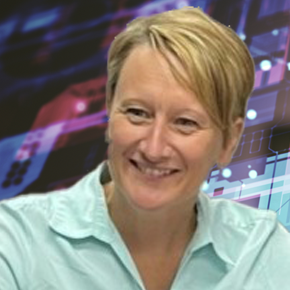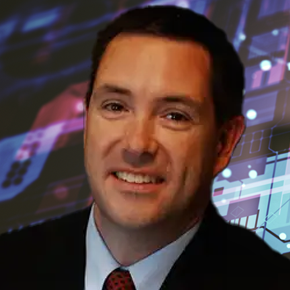November 7, 2022
What is Design and Production for Sustainability?

Transcript
Today the push for sustainability in design and production is turning from well-meaning intention to reality, with new tools to help companies align their entire team from design to sourcing to management on the same measurable sustainability goals.
My guest today is an expert in the first bottoms-up tool to help members of design, sourcing, and cost engineering teams evaluate design and production decisions using CO2 as a metric. Gibson Peters is the Sustainability Product Manager at aPriori. He helps manufacturing teams use the aPriori software to calculate the carbon footprint of their products and designs, and to evaluate cost and sustainability trade-offs as early as the design stage and throughout the production and sourcing process. He’s here today to answer some basic questions about design and production for sustainability and to shed light on how software can help. Gibson Peters, welcome to the podcast.
Gibson Peters: Thanks for having me. It’s great to be here.
What is Design and Production for Sustainability
Leah Archibald: From a high level, how would you describe design and production for sustainability?
Gibson Peters: One of the problems people have today is when we talk about sustainability and design, they’re often not spoken about at the same time. Today, you usually design a product, and then when the product is fully designed you hand it over to the life cycle assessment team. Sustainability is not part of their design process.
Leah Archibald: You’re always kind of playing catch up? You’re not really addressing sustainability in the design phase?
Gibson Peters: You’re always playing catch up. The problem is that 80% of the environmental impact of a product is created in the design phase. So, what we’re trying to do with design and production for sustainability is design something that functions, meets your cost expectations, and meets your sustainability goals at the same time.
Leah Archibald: That sounds like a pipe dream. How do you actually do that?
Gibson Peters: It’s a great question. So what we’re doing is allowing people to iterate in real-time how sustainability impacts their products. With aPriori, when you cost a product, you will automatically get your sustainability footprint for that product as well. And so when you look at minimizing the cost of that product, you can see how that affects carbon. And then when you look at changing the design for reducing your carbon, you can see how it impacts cost. So really we’re trying to find the sweet spot of optimizing for both cost and carbon at the same time in the design phase, and giving that feedback early in the process to the designers, to the cost engineers, and to the sourcing professionals.
Leah Archibald: I’ve talked to a lot of executives on the podcast who are talking about sustainability from a top-down approach. “We’ve got to implement these sustainability goals in our company by 2030, so we’ve got to put certain mechanisms in place.” That’s a top-down approach. But what I hear you doing with aPriori is a bottoms-up approach. You are putting this tool in the hands of design engineers so from the beginning when they are creating their solutions to design problems they are trading off sustainability at the same time as trading off manufacturability and cost.”
Gibson Peters: It’s really flexible in that way. What we strive to do is create transparency on why there’s so much carbon or why something costs as much as it does. You make a good point. When you look at it top-down with the tools that were available previously, you only can go so far. The finished mass is usually where it starts and stops. We’re adding a lot of complexity: understanding cycle time, the rough mass, the waste associated with the product, setting targets for that product, and understanding where in that product the CO2 is coming from. What we’re trying to do is take those top-down initiatives and drive those cost and carbon savings throughout by helping people understand where the carbon comes from within that product.
Finding the Hidden CO2 in Manufactured Products
Leah Archibald: I want you to talk a little bit more about the gap that’s been in the marketplace for finding the hidden CO2 in manufactured products. You mentioned finished mass as one of the only metrics that companies have been tracking. What does that leave out?
Gibson Peters: Finished mass leaves out waste. Let’s say I purchase 100 tons of steel, but I don’t know how does that steel really get used in my product. If I look at finished mass alone, I don’t understand the waste associated with a product. So, one of the case studies we’ve done is looking at the waste generated by making the same product via different production models. I’m looking at machining the product versus die casting, which is melting the metal and then putting it into a mold. At first glance a lot of people would think that die casting would be a more carbon-intensive process because of the energy taken to melt the material down.
Leah Archibald: I can see it in my mind, the energy coming off of the melted metal. It’s very hot. It’s carbon going into the atmosphere.
Peters: But depending on how that part is designed, the great thing about die casting is you will use 96%, 97%, or 98% of the metal. Because almost everything that you melt down goes into that product. So it’s very efficient when it comes to waste utilization. When you look at machining, that same part could have a lot of waste when you machine away all that material to get to the finished product. So, you could be wasting two-thirds, and all that material is not captured when you’re looking at only finished mass.
Leah Archibald: So what you’re saying is that the waste material has a huge impact on the CO2, but it hasn’t really been brought into previous models that are being used for sustainability.
Gibson Peters: Right. That’s been a big gap in what we’ve seen with life cycle assessment tools. If I just know my finished mass, but I don’t know how much mass it took to get to that finished mass, that’s a missing part of life cycle assessment.
Leah Archibald: So you are looking into waste material to find the hidden CO2. What else are you looking at?
Gibson Peters: We find the other big driver is cycle time. aPriori has spent the last 20 years building up cost models that really understand cycle time. And the great thing with cycle time is it has a linear correlation to CO2. So, if you’re able to drive down cycle time, you’re able to drive down cost and carbon at the same time.
Can You Reduce Cost While Improving Sustainability?
Leah Archibald: I think in the past the received wisdom in the sustainability conversation is that cost and sustainability are always opposed, meaning it’s always going to be a trade-off. We’re always going to have to pay more money for less of a carbon footprint. And I think the multi-directionality of aPriori’s tool is giving us new ways to look at the question, and actually there are ways to both reduce cost and improve carbon footprint.
Gibson Peters: Absolutely. What we’ve found in a number of case studies is often your initial assumption of where the carbon is coming from isn’t really what drives CO2. Material is one example. Just because you switch material to one that has less carbon per kilogram doesn’t necessarily save the amount of carbon you would assume. Because the new product could be denser, or it could be more rigid. To date we have had these instincts that have been really difficult to quantify, and some of them have been right but some of them have been wrong. Until you can quantify them, you don’t know which is which.
Leah Archibald: There’s not been any quantitative system that’s looked at the full impact of CO2 before this one.
Gibson Peters: Yes, and there’s no industry standard for sustainability that everyone shares.
Leah Archibald: So if you want to start measuring sustainability, where do you start?
Gibson Peters: Well, the first step for everybody is always to create a baseline. I have this product: how much carbon is in that project? aPriori can help you do that, and then we can automate that going forward.
Leah Archibald: What do you mean by automating that?
Gibson Peters: aPriori integrates with PLM, so we can pull things from the PLM system and tell you how much CO2 is in those existing products. Then after that, we help designers think about sustainability when they’re designing new products. We automatically start quantifying how much carbon is in a product. This gives designers a better understanding of product design for sustainability.
Leah Archibald: Gibson Peters, this has been a great conversation. Thank you so much for joining me on the podcast today.
Gibson Peters: Happy to be here. Thank you so much.







